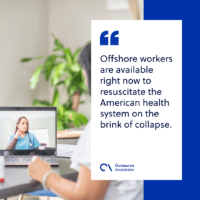A version of this story first appeared in Outsource Accelerator’s Gone Global newsletter. Not a subscriber? You can sign up here.
A life that could’ve been saved
Police detective Tim Lillard was by his wife Ann Picha-Lillard’s side almost every day at the hospital before she died. He observed that whenever medication alarms went off, nurses would scuttle to the medication room, come back, put the medicines down, go to the other room, shut off the alarm, and leave.
They were clearly understaffed. The National Sample Survey of Registered Nurses revealed that the average workweek for nurses rose from 37.5 hours in 2018 to 38.9 hours in 2022. This grim picture shows that the American healthcare system desperately needs help.
If the hospital had had additional staff — even a virtual nurse who kept an eye on her — Tim Lillard suggests that Ann would still be alive today.
What does the modern hospital look like?
The punishing conditions of the COVID-19 pandemic pushed masses of healthcare workers to leave the profession for good. Work burnout coupled with unfair compensation forced them to pursue a different career, ideally something that wouldn’t cause so much stress.
If hospitals are to continue providing proper service amid the continuous surge of patients, they have to take care of their employees. They must have a reasonable workload to perform their tasks well.
The knee-jerk but old-fashioned response would be to announce job openings and wait for a nurse or a physician to apply. But an urgent problem needs an urgent response.
Offshore workers are available right now to resuscitate the American health system on the brink of collapse. Initially, these outsourced staff took care of back-office tasks so that the medical staff could focus on patient-facing assignments.
Fortunately, the rapid advances in technology have allowed remote medical professionals to help floor staff with healthcare delivery. They can now monitor the patient through cameras and sensors that can detect the patient’s vital signs and movements.
If a patient is in critical condition, the virtual staff can alert the floor staff. This is what modern healthcare looks like.
Setting up for success
The healthcare industry is a unique segment in the sense that success is not necessarily seen in the financial sheets. Rather, a hospital’s primary vision is to provide top-notch service amid the continuous surge of patients.
In other industries, if the workload becomes too much, firms could hire more people or stagger some tasks. This does not apply to healthcare. The pandemic taught us that demand in this industry is unpredictable. It must always be ready.
One way to do this is to make the healthcare profession a desirable place to work. These new technologies, coupled with offshore medical staff, are great tools to make healthcare jobs fulfilling and not a soul-sucking profession.
Question for your business
Have you used offshore staff in your operations?




 Independent
Independent





















